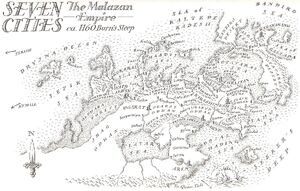
Seven Cities
The Jhag Odhan [Jag Ō-dan][1] were wastes which lay to the west of Seven Cities[2] between the Olphara Forest and the inland Clatar Sea. It was bordered on the west by Nemil.
The plain's low, rolling hills were cloaked in prairie grass so tall it rose to the height of a Teblor's chest. Its basins were filled with clumps of low, bushy trees with leaves of dusty green and grey.[3] Sage brush, cacti, and grey-oaks grew along dried up riverbeds.[4] The odhan resisted attempts to farm it, turning crops to blackened stalks and losing soil to the wind.[4]
The odhan was home to Jhag and Trell.[5] Jhag horses, bred long ago by the Jaghut, ran wild there.[6] It was also populated by herds of Bhederin and striped antelope, Aras deer, tall, honey-coloured wolves,[7] and jackrabbits.[4]
Fringe tribes of Humans lived deep in the odhan. They hunted bhederin with half-wild dogs, driving hundreds of their prey over cliffs to their deaths. The meat was then butchered and smoked. The humans' dogs had their canine teeth cut off when young, although this did not make them any less dangerous to competing predators or other tribes. The dogs were also used to pull travois as domesticated horses were unknown. The tribes used basketry as opposed to clay pots. Lone trees decorated in fetishes, antlers, and bhederin skulls seemed to indicate a kind of spirit worship. Their dead were wrapped and placed on raised platforms to be picked over by crows.[8] It was unclear whether these humans were the Anibar tribes, who were also known to hunt bhederin on the odhan.[9]
Bloodwood was said to have once grown on the odhan, but had been extinct for tens of thousands of years.[10]
A primitive road led into the odhan from Ugarat's west gate.[4]
History
At one time, the odhan's eastern border near Sarpachiya had been occupied by a massive inland saltwater sea that ran from the Thalas Mountains to the Clatar Sea.[11][12] The shores had been home to Logros' clan of the Imass before the Ritual of Tellann, and the hills, once surrounded by the sea, contained their holy sites, hidden caves, and flint quarries.[13][14] After the ritual had been conducted nearby, the newly forged T'lan Imass had broken the ice sheets of the Jaghut at the "first place of defiance" where today stood a line of saw-tooth hills.[15] Long afterwards, the caves were filled with tens of thousands of weapons of those T'lan Imass who had failed.[16]
The odhan had once also been home to an Azath House before it had been mortally wounded by Icarium. Afterwards, the T'lan Imass had impaled the Jaghut child, Phyrlis, on the same spot.[17]
During the invasion of Seven Cities by the Malazan Empire, it was discovered there were still some Jaghut alive in the desert. The T'lan Imass that were supposed to be under command of the Malazans marched off into the desert to fight the Twenty-eighth Jaghut War.[18] Leoman described the state of these Jaghut as "fallen" before they had been killed off. They had been predated on for so long that they had become nomadic savages.[19]
In House of Chains
Karsa Orlong went to the Jhag Odhan searching for a Jhag horse. In the Logros' old caves, he found the weapons of the disgraced Unbound which finally freed them from their prison.[20] The Unbound then observed as Karsa used the old forging chamber to carve his own sword, Delum Thord, from stone. He used the sword to cut down 'Siballe and drive the others away.[21] Exiting the cave, the Teblor pushed aside Onrack T'emlava and Trull Sengar as they arrived.[22]
Deeper in the odhan, Karsa came upon the Jaghut, Cynnigig, who brought him to Phyrlis. The Jaghut assisted him in calling ten to fifteen thousand Jhag horses from which the Teblor chose Havok as his mount.[23]
In The Bonehunters
Karsa Orlong and Samar Dev crossed the Jhag Odhan from Ugarat, making for the coast near Sepik. They witnessed the land's human tribes hunt bhederin and the Teblor tried his own hand at it, killing two bulls.[24] But before they reached their destination they were drawn into the affairs of the Anibar people, who were being terrorised by Tiste Edur.[25]
Notes and references
- ↑ The Grim Tidings Podcast As pronounced by Steven Erikson at 47:30
- ↑ House of Chains, Glossary
- ↑ House of Chains, Chapter 17, US SFBC p.5577
- ↑ 4.0 4.1 4.2 4.3 The Bonehunters, Chapter 5, US SFBC p.217
- ↑ Deadhouse Gates, Chapter 14, US HC p.384
- ↑ House of Chains, Chapter 10
- ↑ House of Chains, Chapter 17, US SFBC p.577-578
- ↑ The Bonehunters, Chapter 9, US SFBC p.406-407
- ↑ The Bonehunters, Chapter 12, US SFBC p.487
- ↑ House of Chains, Chapter 17
- ↑ House of Chains, Chapter 16, US SFBC p.562
- ↑ House of Chains, Chapter 17, US SFBC p.582
- ↑ House of Chains, Chapter 16, US SFBC p.562/565
- ↑ House of Chains, Chapter 17, US SFBC p.574
- ↑ House of Chains, Chapter 16, US SFBC p.565
- ↑ House of Chains, Chapter 14, US SFBC p.522
- ↑ House of Chains, Chapter 17, US SFBC p.583/587
- ↑ Gardens of the Moon, Chapter 9, US HC p.230-231
- ↑ House of Chains, Chapter 10, US SFBC p.393
- ↑ House of Chains, Chapter 14, US SFBC p.522
- ↑ House of Chains, Chapter 17, US SFBC p.569-574
- ↑ House of Chains, Chapter 17, US SFBC p.575-576
- ↑ House of Chains, Chapter 17, US SFBC p.578-586
- ↑ The Bonehunters, Chapter 9
- ↑ The Bonehunters, Chapter 12
